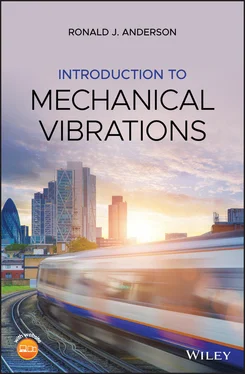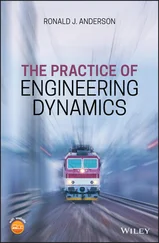Ronald J. Anderson - Introduction to Mechanical Vibrations
Здесь есть возможность читать онлайн «Ronald J. Anderson - Introduction to Mechanical Vibrations» — ознакомительный отрывок электронной книги совершенно бесплатно, а после прочтения отрывка купить полную версию. В некоторых случаях можно слушать аудио, скачать через торрент в формате fb2 и присутствует краткое содержание. Жанр: unrecognised, на английском языке. Описание произведения, (предисловие) а так же отзывы посетителей доступны на портале библиотеки ЛибКат.
- Название:Introduction to Mechanical Vibrations
- Автор:
- Жанр:
- Год:неизвестен
- ISBN:нет данных
- Рейтинг книги:4 / 5. Голосов: 1
-
Избранное:Добавить в избранное
- Отзывы:
-
Ваша оценка:
Introduction to Mechanical Vibrations: краткое содержание, описание и аннотация
Предлагаем к чтению аннотацию, описание, краткое содержание или предисловие (зависит от того, что написал сам автор книги «Introduction to Mechanical Vibrations»). Если вы не нашли необходимую информацию о книге — напишите в комментариях, мы постараемся отыскать её.
is a definitive resource. The text extensively covers foundational knowledge in the field and uses it to lead up to and include: finite elements, the inerter, Discrete Fourier Transforms, flow-induced vibrations, and self-excited oscillations in rail vehicles.
The text aims to accomplish two things in a single, introductory, semester-length, course in vibrations. The primary goal is to present the basics of vibrations in a manner that promotes understanding and interest while building a foundation of knowledge in the field. The secondary goal is to give students a good understanding of two topics that are ubiquitous in today's engineering workplace – finite element analysis (FEA) and Discrete Fourier Transforms (the DFT- most often seen in the form of the Fast Fourier Transform or FFT). FEA and FFT software tools are readily available to both students and practicing engineers and they need to be used with understanding and a degree of caution. While these two subjects fit nicely into vibrations, this book presents them in a way that emphasizes understanding of the underlying principles so that students are aware of both the power and the limitations of the methods.
In addition to covering all the topics that make up an introductory knowledge of vibrations, the book includes:
● End of chapter exercises to help students review key topics and definitions
● Access to sample data files, software, and animations via a dedicated website



 that appears in Equation 1.54. This is the term that was set to zero to determine the equilibrium state (see Equation 1.45) and it is still equal to zero so it can be removed. The equilibrium condition is always a set of constant terms that must be zero for the system not to move and that set of constant terms always reappears in the linearized equation of motion. After removing the equilibrium condition, the linearized equation of motion for the pendulum becomes
that appears in Equation 1.54. This is the term that was set to zero to determine the equilibrium state (see Equation 1.45) and it is still equal to zero so it can be removed. The equilibrium condition is always a set of constant terms that must be zero for the system not to move and that set of constant terms always reappears in the linearized equation of motion. After removing the equilibrium condition, the linearized equation of motion for the pendulum becomes
 with
with  and
and  with
with  ). We write
). We write


 where
where  is a small angle. Since
is a small angle. Since  is a constant, we differentiate to find that
is a constant, we differentiate to find that  and
and  . Substituting into Equation 1.58gives
. Substituting into Equation 1.58gives







 which appears in Equation 1.59can be approximated by the product of these two expressions
which appears in Equation 1.59can be approximated by the product of these two expressions
 term can be neglected as being negligibly small compared to the linear term
term can be neglected as being negligibly small compared to the linear term  since
since  is a small angle. This is at the heart of the linearization process. The linearized EOM becomes
is a small angle. This is at the heart of the linearization process. The linearized EOM becomes
 and its derivatives. The result is
and its derivatives. The result is
 is exactly the same as the equilibrium condition stated in Equation 1.47and it is identically equal to zero by definition so it can be removed from the equation of motion. This will always be the case for vibrational systems. As we progress through the following chapters, we will often say something to the effect of “the gravitational forces are canceled out by preloads in the springs so they can be ignored” where we actually mean that our equations of motion are written for small motions away from an equilibrium state and that we need only be concerned with how the forces in elements change as the system moves slightly away from equilibrium. There will be forces holding the system in equilibrium and they may be large but they always add up to zero. The equilibrium condition for the bead is actually a statement that the moment that the gravitational force exerts about point
is exactly the same as the equilibrium condition stated in Equation 1.47and it is identically equal to zero by definition so it can be removed from the equation of motion. This will always be the case for vibrational systems. As we progress through the following chapters, we will often say something to the effect of “the gravitational forces are canceled out by preloads in the springs so they can be ignored” where we actually mean that our equations of motion are written for small motions away from an equilibrium state and that we need only be concerned with how the forces in elements change as the system moves slightly away from equilibrium. There will be forces holding the system in equilibrium and they may be large but they always add up to zero. The equilibrium condition for the bead is actually a statement that the moment that the gravitational force exerts about point  is exactly equal and opposite to the moment about
is exactly equal and opposite to the moment about  due to the centripetal acceleration.
due to the centripetal acceleration.










